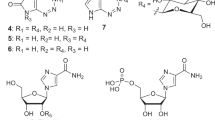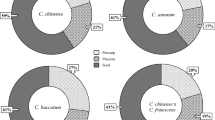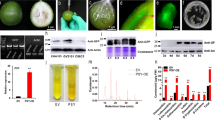Abstract
COCONUT milk is recognized as a rich source of plant cell division inducers, which have become known as kinins1–5. Recently, apple fruitlets were also shown to be a rich source6, and the kinins have been extracted from this tissue and concentrated7. The results showed that the extract contains at least four and probably five independently active kinins as revealed by the tobacco stem pith test8. In this test, blocks of tobacco pith are cultured singly in small tubes on a sucrose–mineral salt medium which also contains the auxin, indolyl-3-acetic acid. An ‘active’ extract, added as a supplement to this medium, induces cell division and the formation of microscopically visible clusters of new cells after 14 days. In control cultures the cells enlarge but do not divide. Reduced nitrogen compounds and hexitols are not required in this assay, nor do they enhance the effect of active extracts as they do in the carrot root phloem test9, which has been used in many studies on coconut milk.
This is a preview of subscription content, access via your institution
Access options
Subscribe to this journal
Receive 51 print issues and online access
$199.00 per year
only $3.90 per issue
Buy this article
- Purchase on Springer Link
- Instant access to full article PDF
Prices may be subject to local taxes which are calculated during checkout
Similar content being viewed by others
References
Strong, F. M., Topics in Microbial Chemistry (John Wiley and Sons, 1958).
The word kinin has also been used for polypeptides which are physiologically active in animal tissues. See, for example, Lewis, G. P., Physiol. Revs., 40, 647 (1960). The plant kinins are unrelated to these substances.
Caplin, S. M., and Steward, F. C., Science, 108, 655 (1948).
Steward, F. C., and Shantz, E. M., Ann. Rev. Plant Physiol., 10, 397 (1959).
Mauney, J. R., Hillman, W. S., Miller, C. O., Skoog, F., Clayton, R. A., and Strong, F. M., Physiol. Plant., 5, 485 (1952).
Goldacre, P. L., and Bottomley, W., Nature, 184, 555 (1959).
Zwar, J. A., Bottomley, W., and Kefford, N. P., Austral. J. Biol. Sci., 16, 407 (1963).
Bottomley, W., Kefford, N. P., Zwar, J. A., and Goldacre, P. L., Austral. J. Biol. Sci., 16, 395 (1963).
Pollard, J. K., Shantz, E., and Steward, F. C., Plant Physiol., 36, 492 (1961).
Author information
Authors and Affiliations
Rights and permissions
About this article
Cite this article
ZWAR, J., KEFFORD, N., BOTTOMLEY, W. et al. A Comparison of Plant Cell Division Inducers from Coconut Milk and Apple Fruitlets. Nature 200, 679–680 (1963). https://doi.org/10.1038/200679a0
Issue Date:
DOI: https://doi.org/10.1038/200679a0
This article is cited by
Comments
By submitting a comment you agree to abide by our Terms and Community Guidelines. If you find something abusive or that does not comply with our terms or guidelines please flag it as inappropriate.



